#European Colonies
Explore tagged Tumblr posts
Text
Forget 'Walking The Plank.' Pirate Portrayals—From Blackbeard to Captain Kidd—Are More Fantasy Than Fact.
How we think famous swashbucklers walked, talked, and dressed didn't come from the history books, so where did these pirate myths come from?
— By Jamie L. H. Goodall
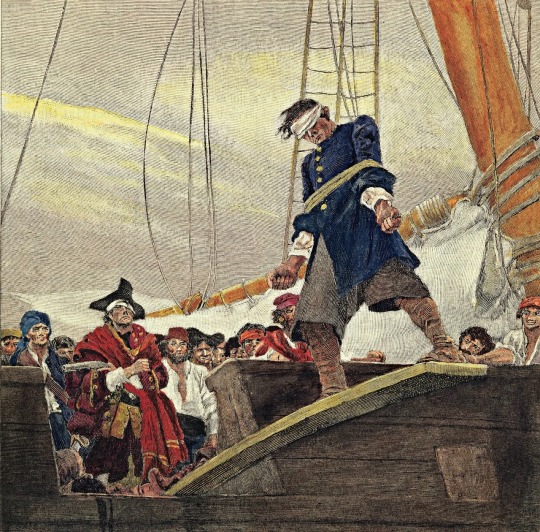
An illustration from 19th-century artist Howard Pyle depicts a man being forced to walk the plank. Although there is no record of this type of punishment, it remains popular in pirate mythology. Photograph By Image Courtesy of Bridgeman Images
Say “pirate,” and people envision grizzled men with eye patches, parrots, and treasure maps. They picture buccaneers forcing their victims to walk the plank, and crying “Shiver me timbers” as they fly the Jolly Roger flag. It turns out, many of these stereotypes are not true. Pirates have been around for nearly as long as people have sailed the world’s waters, and, in fact, still exist. It’s just how they’ve been depicted that’s often misleading. So where did these misinterpretations come from?

A replica pirate ship cruising the Caribbean Sea near the Dominican Republic. Photograph By Thomas Grau, Alamy Stock Photo
Pirate Fashion
Pirates are commonly portrayed wearing colourful attire. He may sport as a loose-fitting shirt with a bandana around his head, a scarf around his waist, ripped pants, wearing tattered boots, like Captain Jack Sparrow from the Pirates of the Caribbean film series. Or he may appear a bit foppish, much like Stede Bonnet, the "gentleman pirate" in the 2022 series Our Flag Means Death.

Common pop culture depictions of pirate garb, as shown here in this early 20th century artwork, are often based on fanciful descriptions of their attire and language. Photograph By Image Courtesy of Bridgeman Images
Unfortunately, these looks are just not true. Much of this ostentation came from American artist Howard Pyle, who took his inspiration from Spanish bandits of the late 19th century. Sailors in the 18th century, pirates included, wore things such as loose pants cut off at the knee and thigh-length blouses.
Prosthetic limbs are another common pirate trait. It’s true some pirates had a wooden leg or hook hand, though it probably wasn’t the norm. More often than not, amputations at sea were likely a death sentence. While ships carried medicine chests, and medical care was often meted out by someone on the crew, infection and blood loss could lead to death. Even if a pirate survived an amputation, his ability to fight would be limited. But losing a limb didn’t mean one could not continue on the ship; the person might serve the crew, for instance, as a cook.
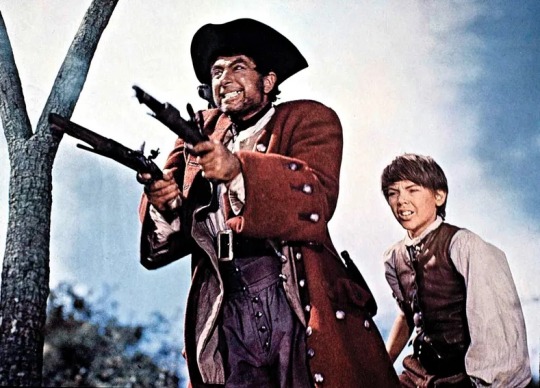
Many pirate clichés stem from the 1950 film 'Treasure Island,' featuring Robert Newton as the fictional pirate Long John Silver. Photograph By United Archives GMBH, Alamy Stock Photo
Pirate Talk
Common pirate phrases—such as Arrrrr me mateys!” and “Shiver me timbers!”—are common in pirate movies and pop culture. But they’re not legitimate things a pirate would actually have said. Robert Louis Stevenson imagined some of them for his 1883 novel Treasure Island, published more than 150 years after the “golden age” of piracy.
The trope of talking like a pirate is mostly a product of 20th-century Hollywood. In particular, British actor Robert Newton, who played both Blackbeard and Long John Silver. His portrayal of the fictional captain in the 1950s rendition of Treasure Island used an exaggeration of his own West Country accent and would define the sound of a pirate's accent. His portrayal also popularised many of the sayings associated with pirates today. In reality, pirates most probably spoke in a manner similar to all sailors of the time.
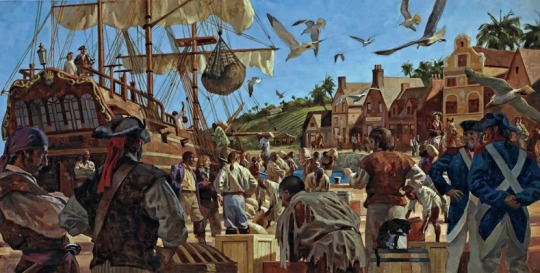
An artist imagines the often-willing markets pirates found throughout the Atlantic world for their stolen loot. Transatlantic trade was critical for the success of European colonies. Photograph By Gregory Manchess
Treasure, Buried or Otherwise
Captain Kidd may have buried his treasure, but that was a rare exception for most pirates. Typically, they spent their ill-gotten gains on women and alcohol at pirate-friendly ports as quickly as they could. Burying treasure would be dangerous due to shifting sands and tides, so one might easily lose their treasure. And there was a distinct lack of trust, not knowing if others might deceptively go back to dig up the treasure on their own.
Also, much of the loot pirates collected was not in the form of silver or gold. Such treasure would have been difficult to come by. The more common "booty" would have been whatever goods or commodities they could get their hands on, including timber, furs, silks, cotton, spices, and medical supplies. They also loaded up on items to perform necessary repairs on their ships, including cable, rigging, and sails.

Top Left: A gold bar and coins recovered from the Spanish galleon 'Las Maravillas' that wrecked in 1656 near the Bahamas. Photograph By Jeff Rotman, Nature Picture Library, Alamy Stock Photo Top Right: Prized Spanish coins, or pieces of eight, recovered from the wreck of the 'Whydah Gally'. Photograph By Zuma Press Inc., Alamy Stock Photo Bottom: Wooden treasure chests were typically studded with metal to reinforce them. Photograph By Andyroland, IStock, Getty Images
Pirate Codes
There is evidence that many pirate crews adopted a code of honour or articles of agreement, mostly to keep order on board the ship. These codes dealt with everything from how to divvy up loot, to what happened to pirates if they became injured in the line of duty, to how bad behaviour would be dealt with, to how prisoners would be treated. Some pirate articles have survived to this day, including the code of Englishman George Lowther and his crew, which, for example, compensated a person who lost a limb during a skirmish.

The 1724 articles of Captain John Phillips of the 'Revenge' discuss matters such as theft on board the ship and compensation for limbs lost during battle. Photograph By British Library Board. All Rights Reserved, Bridgeman Images
If a pirate violated the code, it is unlikely they were made to "walk the plank." Little to no historical evidence exists to support that practice, which was largely pulled from fiction, including Treasure Island. If victims were punished in some way, it was typically via keelhauling. Keelhauling was arguably a more hideous fate that involved an individual being tied to a rope and dragged under the ship. Victims of keelhauling either died by bleeding out from injuries inflicted by barnacles on the hull of the ship or by drowning. Other forms of punishment ranged from being thrown overboard to being lashed to being marooned on a desert isle.
Pirate Ships 🛳️ 🚢
Most pirates did not sail Spanish galleons, or even the frigates such as Captain Jack Sparrow’s Black Pearl. They favoured small, more manoeuvrable vessels, which allowed easy escape from larger warships that chased them. During the 16th and 17th centuries, sloops were the most common choice for pirates. They were quick and had a shallow draft, making easier escape into shallow waters. Schooners were another favourite of pirates. Similar to sloops, schooners were fast, simple to manoeuvre, and could easily hide in estuaries because of their shallow draft.

Top: A replica of the 17th-century Spanish galleon 'Neptune'. Photograph By Volodymyr Dvornyk, Shutterstock Middle: A crew raises the anchor from what is believed to be the remains of the pirate Blackbeard’s flagship, 'Queen Anne’s Revenge.' It was discovered in Beaufort Inlet, in Carteret County, North Carolina. Photograph By AP Photo, Robert Willett, The News & Observer
Bottom Left: The National Museum of the Royal Navy in Hampshire, England, displays a Jolly Roger that once belonged to Admiral Richard Curry, who seized it from pirates off the North African coast in 1790. Photograph By Andrew Matthews, Getty Images Bottom Right: Coves, such as this one near Bridgetown, Barbados, would have made perfect hideouts for pirates. Photograph By Fabio Mauri, Eyeem, Getty Images
And, despite popular myth, most pirates did not fly the famous Jolly Roger—a skull and crossbones symbol on a black flag. Some flew a black flag, which meant the pirate was willing to give quarter, while a red flag meant blood and certain death. Blackbeard’s flag showed a skeleton holding a spear pointing at a bleeding heart. Pirate crews also often held the flags of several different nations so they could raise a particular flag to signal being “friendly” to a passing ship, only to raise their pirate flag once they were in close enough range to attack said vessel.
Pirate Fights
One thing that most of the pop culture depictions of pirates got somewhat right is that they liked versatile weapons. Cutlasses, short swords with a slightly curved blade, could be used to effectively fight in the confined areas of a ship and could also be used to butcher meat.
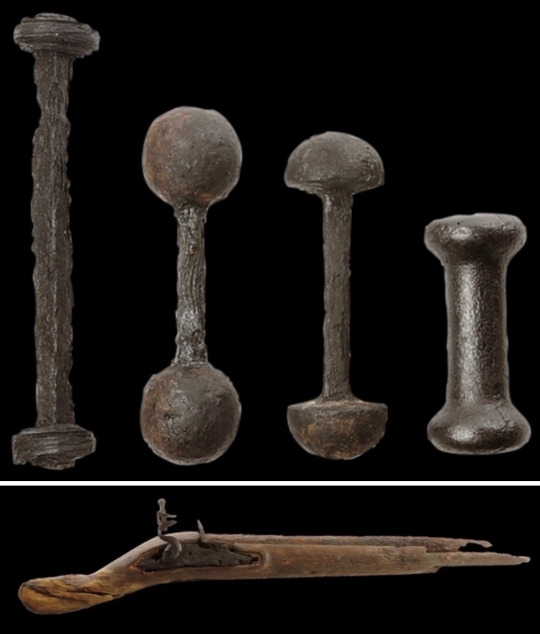
Top: Bar shot were common tools for pirates, who used them at close range to destroy the rigging and sails of enemy ships. Due to the weights on either end of the bars, they would spin uncontrollably after being fired from a cannon. Bottom: This musket’s barrel and stock were cut down, likely so a pirate could more easily use it in close combat. Photographs By Kenneth Garrett
Pirates also enjoyed using a gun known as a blunderbuss. It had a distinct flared muzzle that sprayed small lead balls at intended victims. Cannons were also common onboard pirate ships. They could be loaded with chain shot (two cannonballs chained together), grapeshot (small cannonballs), or basic cannonballs. Their targets often didn’t stand a chance.
While books, movies, and popular culture may have taken liberty with descriptions of pirates through the ages, these pillagers have terrorised the seas for more than 2,000 years in one form or another, plundering victims and striking fear into their hearts. The most recent pirates work off the coasts of Somalia and Malaysia, looking far different from the “golden age” of piracy depictions. But one thing remains true: They are just as intimidating.

The 18th-century painting 'Anne Bonny, Female Pirate' by Fortunino Matania depicts Anne Bonny and an accomplice taking two sailors prisoner. Photograph By Image Courtesy of Historia, Shutterstock
#Culture | History#Pirate Portrayals#Blackbeard | Captain Kidd#Fantasy | Fact#Pirate Mythology#Pirate Ship 🛳️ 🚢#Pirate Garb#Fanciful | Descriptions#Attire Language#Treasure Island#Transatlantic Trade#European Colonies#Bahamas 🇧🇸
12 notes
·
View notes
Text
"this is a universal queer experience"
>ask if it's universal or white
>they don't understand
>I pull out a diagram explaining what is universal and what is white
>they laugh and say "It's a good experience sir"
>I'm a native american trans woman
>Experience is white
#spinning my web#based off the one post going around#anyways.#other poc peer review plz#also europeans warning you in advance dont be annoying. youre just as bad about this as your colonies.
19K notes
·
View notes
Text




#congo exploitation#clean energy agenda#developed countries#african lives#black lives#european countries#majority white countries#black activists#crime against humanity#african humanity#environmental justice#resource extraction#human rights abuses#colonial legacy#economic imperialism#racial injustice#international activism#african exploitation#global inequality#congo#resource exploitation#human rights#clean energy#white countries#exploitation of resources#exploitation of people
888 notes
·
View notes
Text
heard a British guy on tiktok casually refer to the Malvinas Islands as a part of "British colonial PAST" and I had to stare into the camera like in the office like brother that is the cognitive level we are dealing with today *sighs*
#the colonial “past” was less than 40 years ago my man#the frustrating thing was that he was clearly on argentina side but#yeah....#white europeans willd never fully grasp the effects on *their* colonialism because to them it only existed on history books#it's disheartening to say the least#la parte que mas impotencia me da es que para ellos obviamente fue un conflicto menor y a nosotros todavia nos sangra abiertamente la herid#o cuando dicen “pero los isleños votaron que querian seguir siendo ingleses”#uy que noticia hermano#breaking news: colonists decide to keep the nationality of their colonist empire which placed them there in the first place#Argentina#islas malvinas#rants#politics#sofiverse
292 notes
·
View notes
Text
Just an odd thought that I’m wondering if people are in the same boat about:
#i 100% Think my two blorbos would tolerate me at best.#poll#historical#napoleonic wars#history#general history#naval history#habsburg history#russian history#military history#european history#french history#medical history#tudor history#american history#danish history#Italian history#british history#roman history#colonial history#frevblr#French Revolution#Dutch history#Spanish history#portuguese history#Japanese history#Chinese history#Korean history#cold war era#cold war history
140 notes
·
View notes
Text
colonization wasn't started by the europeans in the 1500s.
so stop trying to demonize Europe and America for what they have don't that MANY cultures around the world have already done.
and yes using the term "colonizer" is a racial slur and stop suing it.
#colonization#colonialsm#colonies#european history#englands#uk#america#france#dutch#enlglish#white people#colonizer#racial slurs#rome#greece#asia
412 notes
·
View notes
Text
Mom? Can you pick me up? People on Twitter are doing noble savage "European colonialism is worse than Islamic colonialism" arguments again.
#Personal#history#Just because the linguistic and cultural impacts of European colonialism were more enduring doesn't mean Islamic colonialism wasn't just as#violent and terrible
569 notes
·
View notes
Text
I know many people will watch Dale Jennings use a tanning bed in the Newsreader and think it's just an excuse for some eye candy, which sure, it's probably partly that. But also if you aren't Australian you may not know that tanning beds were banned nation-wide no exceptions in 2015 after a decades long campaign by the skin cancer council of Australia to combat Australia having the highest skin cancer rates in the world. Even before the 2015 ban, their use became extremely restricted by age and commercial use. So, someone casually using a tanning bed in Australian media has become a signifier of something being set in the past. My first reaction seeing that scene as an Australian (even as one who Likes™ Sam Reid) was wincing and cringing at the sight of the tanning bed because tanning beds are quite functionally illegal here now and have been for at least a decade so seeing someone using one in a movie is not dissimilar to watching someone be prescribed smoking by a Doctor in a film set in the 50s. It's kinda like an "oh god yeah people used to that didn't they? Yikes!" But if you're not Australian, you might not know that Dale Jennings using a tanning bed is as much a period-accurate detail to signify the past, as much as it is also inevitably an excuse for Sam to have his clothes off lmfao
#the newsreader#sam reid#only one other country has skin cancer rates as high as us! give it up for fellow genocidal colonial state: Israel!#its almost like ..... europeans shouldn't be fucking here!#but i digress
96 notes
·
View notes
Text
Tallying every single tree in the kingdom. Endangered South Asian sandalwood. British war to control the forests. European companies claim the ecosystem. Failure of the plantation. Until the twentieth century, the Empire couldn't figure out how to cultivate sandalwood because they didn't understand that the plant is actually a partial root parasite, so their plantation monoculture approach of eliminating companion species was self-defeating. French perfumes and the creation of "Sandalwood City".
---
Selling at about $147,000 per metric ton, the aromatic heartwood of Indian sandalwood (S. album) is arguably [among] the most expensive wood in the world. Globally, 90 per cent of the world’s S. album comes from India [...]. And within India, around 70 per cent of S. album comes from the state of Karnataka [...] [and] the erstwhile Kingdom of Mysore. [...] [T]he species came to the brink of extinction. [...] [O]verexploitation led to the sandal tree's critical endangerment in 1974. [...]
---
Francis Buchanan’s 1807 A Journey from Madras through the Countries of Mysore, Canara and Malabar is one of the few European sources to offer insight into pre-colonial forest utilisation in the region. [...] Buchanan records [...] [the] tradition of only harvesting sandalwood once every dozen years may have been an effective local pre-colonial conservation measure. [...] Starting in 1786, Tipu Sultan [ruler of Mysore] stopped trading pepper, sandalwood and cardamom with the British. As a result, trade prospects for the company [East India Company] were looking so bleak that by November 1788, Lord Cornwallis suggested abandoning Tellicherry on the Malabar Coast and reducing Bombay’s status from a presidency to a factory. [...] One way to understand these wars is [...] [that] [t]hey were about economic conquest as much as any other kind of expansion, and sandalwood was one of Mysore’s most prized commodities. In 1799, at the Battle of Srirangapatna, Tipu Sultan was defeated. The kingdom of Mysore became a princely state within British India [...]. [T]he East India Company also immediately started paying the [new rulers] for the right to trade sandalwood.
British control over South Asia’s natural resources was reaching its peak and a sophisticated new imperial forest administration was being developed that sought to solidify state control of the sandalwood trade. In 1864, the extraction and disposal of sandalwood came under the jurisdiction of the Forest Department. [...] Colonial anxiety to maximise profits from sandalwood meant that a government agency was established specifically to oversee the sandalwood trade [...] and so began the government sandalwood depot or koti system. [...]
From the 1860s the [British] government briefly experimented with a survey tallying every sandal tree standing in Mysore [...].
Instead, an intricate system of classification was developed in an effort to maximise profits. By 1898, an 18-tiered sandalwood classification system was instituted, up from a 10-tier system a decade earlier; it seems this led to much confusion and was eventually reduced back to 12 tiers [...].
---
Meanwhile, private European companies also made significant inroads into Mysore territory at this time. By convincing the government to classify forests as ‘wastelands’, and arguing that Europeans would improves these tracts from their ‘semi-savage state’, starting in the 1860s vast areas were taken from local inhabitants and converted into private plantations for the ‘production of cardamom, pepper, coffee and sandalwood’.
---
Yet attempts to cultivate sandalwood on both forest department and privately owned plantations proved to be a dismal failure. There were [...] major problems facing sandalwood supply in the period before the twentieth century besides overexploitation and European monopoly. [...] Before the first quarter of the twentieth century European foresters simply could not figure out how to grow sandalwood trees effectively.
The main reason for this is that sandal is what is now known as a semi-parasite or root parasite; besides a main taproot that absorbs nutrients from the earth, the sandal tree grows parasitical roots (or haustoria) that derive sustenance from neighbouring brush and trees. [...] Dietrich Brandis, the man often regaled as the father of Indian forestry, reported being unaware of the [sole significant English-language scientific paper on sandalwood root parasitism] when he worked at Kew Gardens in London on South Asian ‘forest flora’ in 1872–73. Thus it was not until 1902 that the issue started to receive attention in the scientific community, when C.A. Barber, a government botanist in Madras [...] himself pointed out, 'no one seems to be at all sure whether the sandalwood is or is not a true parasite'.
Well into the early decades of twentieth century, silviculture of sandal proved a complete failure. The problem was the typical monoculture approach of tree farming in which all other species were removed and so the tree could not survive. [...]
The long wait time until maturity of the tree must also be considered. Only sandal heartwood and roots develop fragrance, and trees only begin developing fragrance in significant quantities after about thirty years. Not only did traders, who were typically just sailing through, not have the botanical know-how to replant the tree, but they almost certainly would not be there to see a return on their investments if they did. [...]
---
The main problem facing the sustainable harvest and continued survival of sandalwood in India [...] came from the advent of the sandalwood oil industry at the beginning of the twentieth century. During World War I, vast amounts of sandal were stockpiled in Mysore because perfumeries in France had stopped production and it had become illegal to export to German perfumeries. In 1915, a Government Sandalwood Oil Factory was built in Mysore. In 1917, it began distilling. [...] [S]andalwood production now ramped up immensely. It was at this time that Mysore came to be known as ‘the Sandalwood City’.
---
Text above by: Ezra Rashkow. "Perfumed the axe that laid it low: The endangerment of sandalwood in southern India." The Indian Economic and Social History Review, Volume 51 (2014), Issue 1, pages 41-70. First published online 10 March 2014. DOI: 10.1177/0019464613515533 [Bold emphasis and some paragraph breaks/contractions added by me. Italicized first paragraph/heading in this post added by me. Presented here for commentary, teaching, criticism purposes.]
#a lot more in full article specifically about#postindependence indian nationstates industrial extraction continues trend established by british imperial forestry management#and ALSO good stuff looking at infamous local extinctions of other endemic species of sandalwood in south pacific#that compares and contrasts why sandalwood survived in india while going extinct in south pacific almost immediately after european conques#abolition#ecology#imperial#colonial#landscape#indigenous#multispecies#tiger#tidalectics#archipelagic thinking#intimacies of four continents#carceral geography#geographic imaginaries#haunted#indigenous pedagogies#black methodologies#tigers and elephants#whither the maneater
278 notes
·
View notes
Text


i really think this was the novel that birthed ecocriticism like my god. 1851. 1851!
#1 8 5 1 ?#I really have to pause every few pages at how beautifully it works through the brutality of capitalism and colonialism and industrial#fishing and just take a step back. he wrote this in 1851.#Melville makes every other 19th and 20th century author appear so hopelessly uneducated and tone deaf#like you grow up reading European fiction and quite nothing shows how starkly ensconced these authors were#in their colonial upper class privilege until you read something that shows you the beating#gory heart of the economic structure at the time#THIS PREDATED CAPITAL VOLUME 1#he wrote this!!! he wrote this before Marxist vocabulary even EXISTED#jes us ch r i st#moby dick#Herman Melville
120 notes
·
View notes
Text

Aldo Gamba (Italian, 1881-1944) General Maximo Gomez Monument, 1935 Monument in front of El Malecón in Havana, Cuba
#Aldo Gamba#pre fidel cuba#Cuba#Cuban#Maximo Gomez#Monument#art#fine art#european art#classical art#europe#european#fine arts#europa#mediterranean#Spanish#spain#1935#1800s#Cuban independence#Spaniard#colonial spanish#colonialism#colonization#italian art#italian#italy#maximo gomez#world history#historic
53 notes
·
View notes
Text
I started this blog because I couldn't stop thinking about what the world would look like if men never existed (or somehow went extinct, with women able to procreate without them). What things might have been created or discovered sooner, what cultures might have never been wiped out, what huge industries like the trans-atlantic slave trade would never have existed?
It's a mind boggling thought experiment.
I basically wanted to focus on women’s lives and cultural impact with complete disregard for men as much as possible. It's proven more possible than I expected lol.
#colonialism is a huge change#i imagine most empires wouldn't have arisen though some may have#no united states as it is... maybe an american union like the european union though
52 notes
·
View notes
Text

#christopher columbus#christopher columbus atrocities#indigenous genocide#colonization brutality#native exploitation#colonial oppression#indigenous resistance#historical revisionism#indigenous rights#european imperialism#slave trade history#columbus legacy of violence
449 notes
·
View notes
Text
yes when a trans woman laments how patriarchy and fascism eradicated a large portion of her history she is being a "doomer" i'll be sure to not catastrophize about what the past could be in the future
#hold on i can go back to my misandrist arc if trans men keep treating me like this#see it's funny cuz being a doomer about the past is as real as misandry is#if i wasn't posting this at 3 am i could probably start playing transmisogynist bingo#we still don't talk abt how a large number of those examples are recent history and european#i like the additions but my point abt colonialism doesn't change when i learn about a french transfem surprisingly
32 notes
·
View notes
Text
sometimes I'll softblock a follower if they're leaving too many annoying comments or being too seppo. hmmm not feeling it anymore bye.
#hmmm do you think perhaps the sense of scale in countries in the Americas has something to do with colonialism?#''Europeans can't understand living somewhere that's big because of colonialism''#very silly
35 notes
·
View notes
Text




Examples of Sino-Portuguese architecture in Singapore and Malaysia.
This hybrid style incorporating elements of both Chinese and Portuguese architectural styles can be seen in Southern China (Guangdong, Hainan, Macao, etc) and Maritime Southeast Asia, with most prominently conserved and maintained examples being in historically Chinese-populated areas in the Malay Peninsula and Singapore.
Sino-Portuguese tiles and patterns:
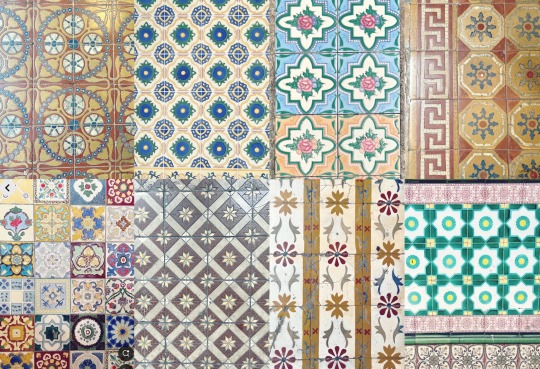
#china#chinese heritage#east asia#chinese culture#chinese#architecture#people’s republic of china#chinese history#Southeast Asia#Guangdong#Hainan#Macau#🇨🇳#sino#Thailand#Singapore#Malaysia#colonial architecture#🇹🇭#🇸🇬#🇲🇾#Peranakan#Sino-Portuguese architecture#Chinese-Portuguese architecture#Chinese-European architecture#courtyards#courtyard houses#asean#Portugal#republic of China
38 notes
·
View notes